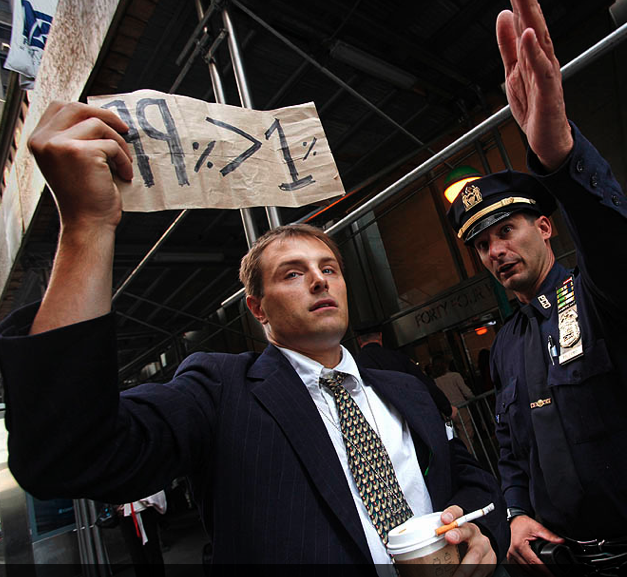
Image Credit: Screenshot capture of photograph by Carolyn Cole / Los Angeles Times
The photograph above was featured this week in The L.A. Times' coverage of the Occupy Wall Steet movement's one-year anniversary. The caption provided beneath the photo states, "A man wanting to join the Occupy protesters on Monday is told to leave Wall Street." The image gives pause, not because a policeman is pictured confronting a protester, but because the man's ethos seems incongruous with that of the anarchist-inspired OWS movement. My recollection of the "Occupied" zone in downtown Austin last winter calls to mind the image of a different kind of a protester, one who looks as committed to battling the elements as he is to changing the status quo. This unidentified man, however, does not look prepared for the scene of mayhem he is allegedly trying to enter. With a cigarette balanced precariously atop his coffee cup, he looks like he's just popped down from the 20th floor to grab some more uppers. It's amusing (or disheartening, depending on your outlook) to imagine him scrawling "99%>1%" on a scrap of paper before venturing into the mob that separates him from the nearest Starbucks. But this is pure speculation. It's equally likely that the man in the photograph is an overworked reporter, or an analyst who has thousands of dollars of debt from student loans. Perhaps he was walking by the OWS demonstration, got inspired, and decided to join on a whim. Either way, the photographer caught him looking weary, unimpassioned, and in a moment of half-hearted negotiation with the police, which is why this photo provides a useful illustration of the phenomenon known as slacktivism.
Slacktivism (slacker activism) describes a distinctly inactive method of supporting a cause. The steps slacktivists take to achieve their supposed ideals require little effort, cost, or forethought (many are easily performed through social networks' approval systems and news/media sharing functions). Despite this, some have argued that the proper channeling of slactivism can lead to positive social change.
I want to suggest, in a very rough and cursory way, that the OWS man's paper-bag appeal to the 99% is similar to slacktivists' tags and tweets. The encompassing nature of Occupy's slogan--"We are the 99%"--has diluted the definition of an activist, and extended it to include anyone with a sign who wishes (temporarily? disingenuously?) to harness the power of an enormous group. Social media platforms can have the same effect. With the right virtual signage anyone can pose as an activist; anyone can reap the social and commercial benefits of participating in far-reaching online campaigns; and finally, anyone can avoid accountability for actions and purported views by maintaining distance between real and digital identities. (I might be accused of doing that in this very blog post.)
Yet on the other hand, the makeshift, handmade quality of the OWS man's sign marks it as an analog, not a digital, production. It has the appearance of a homeless person's battered highway sign--a text that demands attention because of the dissonance between its sensitive message and crude medium (i.e. cardboard). Thus, the OWS protester can claim a certain ethical connection to his sign that is unavailable to wielders of pre-made placards, like the attendees of the recent Democratic National Convention (below). Visuals from the DNC got me thinking about what it means, and what is argued, when one waves around a sign that is identical to hundreds of others nearby, and that was designed, manufactured and supplied to you by a political organization. In the landscape of a highly visible crowd such as the DNC's, one's voice is essentially reduced to one's sign. A crowd that enthusiastically agrees to broadcast a unified and pre-determined message is one that values a brand of solidarity over the opportunity to air personal sentiments or opinions. Or perhaps it is simply made up of individuals who are used to re-posting and re-tweeting ready-made internet memes and allowing those rhetorical texts to speak for them online.

Image Credit: occupyilluminati.com
In light of the eruption this month of violent demonstrations all over the Arab world, the question of how activism can and should evolve seems all important. I won't outline directions for that evolution here. But I will say that the kind of conviction that has mobilized thousands to take to the streets of Muslim countries, recasts the Occupy Wall Street photo (above), along with the possibility that progressive U.S. activism is becoming more dispersed and mainstream, in a sober light.

Recent comments
2 years 29 weeks ago
2 years 44 weeks ago
2 years 44 weeks ago
2 years 50 weeks ago
3 years 4 weeks ago
3 years 4 weeks ago
3 years 4 weeks ago
3 years 6 weeks ago
3 years 6 weeks ago
3 years 6 weeks ago